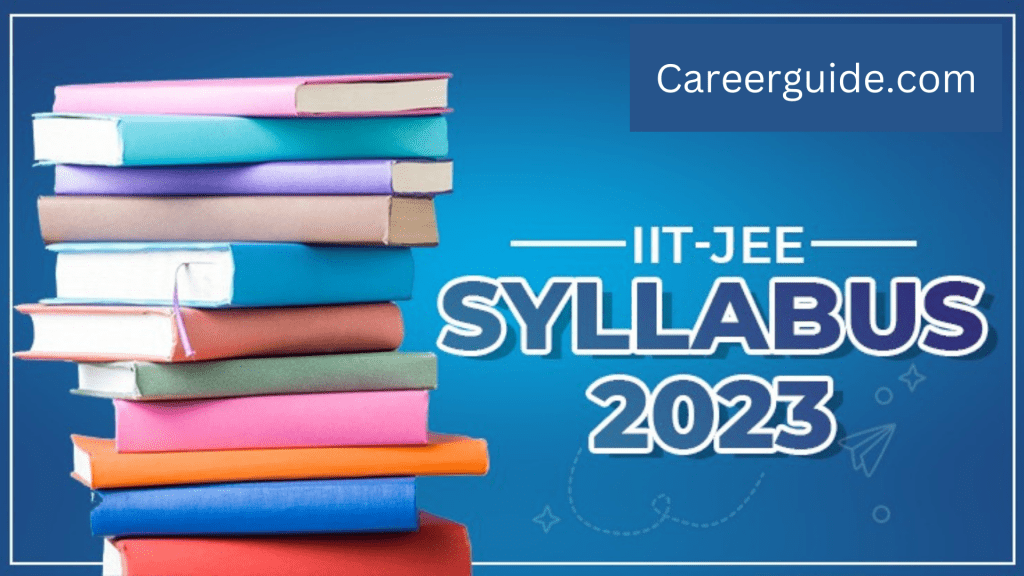The JEE Mains syllabus is an extensive curriculum that covers topics from Physics, Chemistry, and Mathematics subjects of the 10+2 level. The syllabus is designed to test the candidate’s understanding of the concepts, principles, and their application in solving problems.
JEE MAIN 2023: HIGHLIGHTS
 Counselling for JEE Main 2023 (JoSAA) will be Released Soon; Check Counselling Process & More.
Counselling for JEE Main 2023 (JoSAA) will be Released Soon; Check Counselling Process & More.
 The official JEE Main 2023 Cut Off has been made public; Check Cutoff & More.
The official JEE Main 2023 Cut Off has been made public; Check Cutoff & More. The JEE Main 2023 Session 2 Results were released on April 29, 2023; Check the full results.
The JEE Main 2023 Session 2 Results were released on April 29, 2023; Check the full results.
 On April 29, 2023, the JEE Main 2023 Final Answer Key (Session 2) was made available; Check paper analysis & answer key here.
On April 29, 2023, the JEE Main 2023 Final Answer Key (Session 2) was made available; Check paper analysis & answer key here.
The JEE Main 2023 (Session 2) exams have they been completed? – Yes, the dates for the exams are from April 6 to April 15, 2023.
Is JEE Main test and CUET will be combined in 2023? – According to the minister of education, there are no such plans for the upcoming two years.
How many JEE Main 2023 attempts are permitted? – Two attempts
Will JEE 2023 be challenging? – Your degree of study and preparation will affect how difficult the exam is. To Download Physics , Chemistry , Maths Notes Click Here.
JEE Main 2023 Paper 1 syllabus for PCM:

Subject | Topics |
|---|---|
| Mathematics | Sets, Relations, and Functions |
| Complex Numbers and Quadratic Equations | |
| Matrices and Determinants | |
| Permutations and Combinations | |
| Mathematical Induction | |
| Binomial Theorem and Its Simple Applications | |
| Sequences and Series | |
| Limit, Continuity and Differentiability | |
| Integral Calculus | |
| Differential Equations | |
| Co-ordinate Geometry | |
| Three Dimensional Geometry | |
| Vector Algebra | |
| Statistics and Probability |
Subject | Topics |
|---|---|
| Physics | Physics and Measurement |
| Kinematics | |
| Laws of Motion | |
| Work, Energy, and Power | |
| Rotational Motion | |
| Gravitation | |
| Properties of Solids and Liquids | |
| Thermodynamics | |
| Kinetic Theory of Gases | |
| Oscillations and Waves | |
| Electrostatics | |
| Current Electricity | |
| Magnetic Effects of Current and Magnetism | |
| Electromagnetic Induction and Alternating Currents | |
| Electromagnetic Waves | |
| Optics | |
| Dual Nature of Matter and Radiation | |
| Atoms and Nuclei |
Subject | Topics |
|---|---|
| Chemistry | Physical Chemistry |
| – Some Basic Concepts in Chemistry | |
| – States of Matter | |
| – Atomic Structure | |
| – Chemical Bonding and Molecular Structure | |
| – Chemical Thermodynamics | |
| – Solutions | |
| – Equilibrium | |
| – Redox Reactions and Electrochemistry | |
| – Chemical Kinetics | |
| Inorganic Chemistry | |
| – Classification of Elements and Periodicity in Properties | |
| – General Principles and Processes of Isolation of Metals | |
| – Hydrogen | |
| – s-Block Elements (Group 1 and Group 2 Elements) | |
| – p-Block Elements | |
| – d- and f-Block Elements | |
| Organic Chemistry | |
| – Purification and Characterisation of Organic Compounds | |
| – Some Basic Principles of Organic Chemistry | |
| – Hydrocarbons | |
| – Organic Compounds Containing Halogens | |
| – Organic Compounds Containing Oxygen | |
| – Organic Compounds Containing Nitrogen | |
| – Polymers | |
| – Biomolecules | |
| – Chemistry in Everyday Life |
JEE Mains Exam Pattern 2023 Paper 1
Exam Mode | Computer-based Test (CBT) |
|---|---|
| Language Medium | English, Hindi, and other regional languages (depending on the exam center) |
| Duration | 3 hours |
| Type of Questions | Multiple Choice Questions (MCQs) and Numerical Value-based Questions (NVTs) |
| Total Questions | 90 |
| Total Marks | 300 |
| Marking Scheme | +4 marks for each correct answer, -1 mark for each incorrect answer (except for NVTs), and no negative marking for unanswered questions and NVTs |
| Subjects and distribution of questions | Mathematics: 30 MCQs and 5 NVTs (100 marks), Physics: 30 MCQs and 5 NVTs (100 marks), Chemistry: 30 MCQs and 5 NVTs (100 marks) |
| Total marks distribution | MCQs: 360 marks (120 questions x 4 marks each), NVTs: 60 marks (15 questions x 4 marks each) |
| Eligibility | Candidates who have passed 10+2 or equivalent examination with Physics, Chemistry, and Mathematics as mandatory subjects can apply for JEE Main 2023 Paper 1. |
Jee Mains Weightage – Physics
Topics | Jee Mains Weightage |
|---|---|
| Mechanics | 25% |
| Laws of Motion | |
| Work, energy, and power | |
| Rotational motion | |
| Gravitation | |
| Properties of solids and fluids | |
| Oscillations and waves | |
| Electricity and Magnetism | 17% |
| Electrostatics | |
| Current electricity | |
| Magnetic Effects of Current and Magnetism | |
| Electromagnetic induction and alternating currents | |
| Electromagnetic waves | |
| Modern Physics | 16% |
| Dual nature of matter and radiation | |
| Atoms and nuclei | |
| Electronic devices | |
| Optics | 10% |
| Ray optics and optical instruments | |
| Wave optics | |
| Thermodynamics | 10% |
| Thermodynamic processes | |
| Kinetic theory of gases | |
| Laws of thermodynamics | |
| SHM & Waves | 10% |
| Simple harmonic motion (SHM) | |
| Waves | |
| Others | 12% |
| Electronic devices | |
| Communication systems | |
| Experimental skills |
Jee Mains Weightage – Chemistry
Topics | Weightage |
|---|---|
| Physical Chemistry | 35% |
| Basic concepts in chemistry | |
| States of matter | |
| Atomic structure | |
| Chemical bonding and molecular structure | |
| Chemical thermodynamics | |
| Solutions | |
| Equilibrium | |
| Redox reactions and electrochemistry | |
| Chemical kinetics | |
| Inorganic Chemistry | 30% |
| Classification of elements and periodicity in properties | |
| Hydrogen | |
| Block elements (alkali and alkaline earth metals, group 13 to group 18 elements) | |
| Environmental chemistry | |
| Coordination compounds | |
| General principles and processes of isolation of metals | |
| Organic Chemistry | 35% |
| Purification and characterization of organic compounds | |
| Some basic principles of organic chemistry | |
| Hydrocarbons | |
| Organic compounds containing halogens | |
| Organic compounds containing oxygen | |
| Organic compounds containing nitrogen | |
| Polymers | |
| Biomolecules | |
| Chemistry in everyday life |
Jee Mains Weightage – Maths
Topics | Weightage |
|---|---|
| Algebra | 25% |
| Quadratic equations and expressions | |
| Complex numbers | |
| Progressions and series | |
| Binomial theorem | |
| Permutation and combination | |
| Mathematical induction | |
| Matrices and determinants | |
| Probability | |
| Calculus | 40% |
| Limits and continuity | |
| Differentiability and derivatives | |
| Applications of derivatives | |
| Indefinite and definite integrals | |
| Applications of integrals | |
| Differential equations | |
| Coordinate Geometry | 20% |
| Straight lines | |
| Circles | |
| Conic sections | |
| Three-dimensional geometry |
JEE Main Paper 2 & 3 Syllabus
JEE Main Paper 2 | JEE Main Paper 3 |
|---|---|
| Mathematics: | Mathematics: |
| – Sets, Relations and Functions | – Same as Mathematics in JEE Main Paper 2 |
| – Complex Numbers and Quadratic Equations | |
| – Matrices and Determinants | |
| – Permutations and Combinations | |
| – Mathematical Induction | |
| – Binomial Theorem and Its Applications | |
| – Sequences and Series | |
| – Limit, Continuity, and Differentiability | |
| – Integral Calculus | |
| – Differential Equations | |
| – Coordinate Geometry | |
| – Three Dimensional Geometry | |
| – Vector Algebra | |
| – Statistics and Probability | |
| Aptitude Test: | Aptitude Test: |
| – Awareness of persons, places, buildings, materials, and objects | – Same as Aptitude Test in JEE Main Paper 2 |
| – Texture and objects related to architecture and building environment | |
| – Visualizing three-dimensional objects from two-dimensional drawings | |
| – Visualizing different sides of three-dimensional objects | |
| – Analytical Reasoning | |
| – Mental Ability | |
| Drawing Test: | Planning Based Objective Type Questions: |
| – Understanding of scale and proportion | – General Awareness regarding development issues, government programs/schemes, etc. |
| – Drawing of patterns – both geometrical and abstract | – Comprehension, critical thinking and analytical skills, graphs, charts and map reading skills, simple statistics |
| – Drawing of street scenes and landscapes | – CBSE Class 10th Social Sciences topics on Economics, Geography, Political Science and Sociology |
| – Sketching of activities from memory of urban scenes (public space, market, festivals, street scenes, monuments, recreational spaces etc.) | |
| – Creating two dimensional and three-dimensional compositions using given shapes and forms | |
| – Perspective drawing | |
| – Sketching of human figures, animals and plants |
JEE Mains Exam Pattern for Paper 2 & 3
JEE Main Paper 2:
Subject | No. of Questions | Maximum Marks |
|---|---|---|
| Mathematics | 30 | 120 |
| Aptitude Test | 50 | 200 |
| Drawing Test | 2 | 70 |
| Total | 82 | 390 |
- The exam duration is 3 hours (4 hours for candidates with 40% or more disability).
- Mathematics and Aptitude Test will be conducted in Computer Based Test (CBT) mode, while Drawing Test will be conducted in Pen & Paper (offline) mode.
- Mathematics and Aptitude Test will have objective type questions, while Drawing Test will have subjective type questions in jee mains exam pattern
JEE Main Paper 3:
Subject | No. of Questions | Maximum Marks |
|---|---|---|
| Mathematics | 20 | 100 |
| Aptitude Test | 50 | 200 |
| Planning Based Objective Type Questions | 25 | 100 |
| Total | 95 | 400 |
- The exam duration is 3 hours (4 hours for candidates with 40% or more disability).
- All sections of the exam will be conducted in Computer Based Test (CBT) mode.
- Mathematics and Aptitude Test will have objective type questions, while Planning Based Objective Type Questions will have multiple choice questions.


















